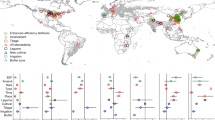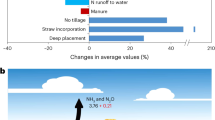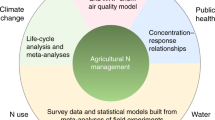Abstract
Reducing cropland ammonia (NH3) emissions while improving air quality and food supply is a challenge, particularly in China where there are millions of smallholder farmers. We tested the effectiveness of a tailored nitrogen (N) management strategy applied to wheat–maize cropping systems in ‘demonstration squares’ across Quzhou County in the North China Plain. The N-management techniques included optimal N rates, deep fertilizer placement and application of urease inhibitors, implemented through cooperation between government, researchers, businesses and smallholders. Compared with conventional local smallholder practice, our NH3 mitigation campaign reduced NH3 volatilization from wheat and maize by 49% and 39%, and increased N-use efficiency by 28% and 40% and farmers’ profitability by 25% and 19%, respectively, with no detriment to crop yields. County-wide atmospheric NH3 and fine particulate matter (with aerodynamic diameter <2.5 μm) concentrations decreased by 40% and 8%, respectively. County-wide net benefits were estimated at US$7.0 million. Our demonstration-square approach shows that cropland NH3 mitigation and improved air quality and farm profitability can be achieved simultaneously by coordinated actions at the county level.
This is a preview of subscription content, access via your institution
Access options
Access Nature and 54 other Nature Portfolio journals
Get Nature+, our best-value online-access subscription
$29.99 / 30 days
cancel any time
Subscribe to this journal
Receive 12 digital issues and online access to articles
$119.00 per year
only $9.92 per issue
Buy this article
- Purchase on Springer Link
- Instant access to full article PDF
Prices may be subject to local taxes which are calculated during checkout





Similar content being viewed by others
Data availability
Data supporting the findings of this study are available within the article and its Supplementary Information. Source data are provided with this paper.
References
Sutton, M. A. et al. Alkaline air: changing perspectives on nitrogen and air pollution in an ammonia-rich world. Phil. Trans. R. Soc. A 378, 20190315 (2020).
Ma, R. et al. Global soil-derived ammonia emissions from agricultural nitrogen fertilizer application: a refinement based on regional and crop-specific emission factors. Glob. Change Biol. 27, 855–867 (2021).
Fertilizer and Pesticide Use Zero Growth Action Target Successfully Achieved in China [in Chinese] (Ministry of Agriculture and Rural Affairs of the People’s Republic of China, 2021); http://www.moa.gov.cn/xw/zwdt/202101/t20210117_6360031.htm
Xu, R. et al. Global ammonia emissions from synthetic nitrogen fertilizer applications in agricultural systems: empirical and process-based estimates and uncertainty. Glob. Change Biol. 25, 314–326 (2019).
Xu, W. et al. Increasing importance of ammonia emission abatement in PM2.5 pollution control. Sci. Bull. 67, 1745–1749 (2022).
Ma, R. et al. Mitigation potential of global ammonia emissions and related health impacts in the trade network. Nat. Commun. 12, 6308 (2021).
Gu, B. et al. Abating ammonia is more cost-effective than nitrogen oxides for mitigating PM2.5 air pollution. Science 374, 758–762 (2021).
Gu, B. et al. A credit system to solve agricultural nitrogen pollution. Innovation 2, 100079 (2021).
Gu, B. et al. Cost-effective mitigation of nitrogen pollution from global croplands. Nature 613, 77–84 (2023).
Sha, Z. et al. Improved soil-crop system management aids in NH3 emission mitigation in China. Environ. Pollut. 289, 117844 (2021).
Ti, C., Xia, L., Chang, S. X. & Yan, X. Potential for mitigating global agricultural ammonia emission: a meta-analysis. Environ. Pollut. 245, 141–148 (2019).
Guo, Y. et al. Air quality, nitrogen use efficiency and food security in China are improved by cost-effective agricultural nitrogen management. Nat. Food 1, 648–658 (2020).
Pinder, R. W., Adams, P. J. & Pandis, S. N. Ammonia emission controls as a cost-effective strategy for reducing atmospheric particulate matter in the Eastern United States. Environ. Sci. Technol. 41, 380–386 (2007).
Three-Year Action Plan to Win the Battle for a Blue Sky [in Chinese] (National Development and Reform Commission of the State Council of the People’s Republic of China, 2018); http://www.gov.cn/zhengce/content/2018-07/03/content_5303158.htm?gs_ws=weixin_636662351573937202&from=timeline&isappinstalled=0
Zhang, W. et al. Closing yield gaps in China by empowering smallholder farmers. Nature 537, 671–674 (2016).
Cui, Z. L. et al. Pursuing sustainable productivity with millions of smallholder farmers. Nature 555, 363–366 (2018).
Huang, X. et al. A high-resolution ammonia emission inventory in China. Glob. Biogeochem. Cycles 26, GB1030 (2012).
MEIC (Multi-Resolution Emission Inventory for China, 2019).
Cheng, J. et al. Pathways of China’s PM2.5 air quality 2015–2060 in the context of carbon neutrality. Natl Sci. Rev. 8, nwab078 (2021).
Tong, D. et al. Dynamic projection of anthropogenic emissions in China: methodology and 2015–2050 emission pathways under a range of socio-economic, climate policy, and pollution control scenarios. Atmos. Chem. Phys. 20, 5729–5757 (2020).
Abdo, A. I. et al. Ammonia emission from staple crops in China as response to mitigation strategies and agronomic conditions: meta-analytic study. J. Clean. Prod. 279, 123835 (2021).
Ma, R. et al. Data-driven estimates of fertilizer-induced soil NH3, NO and N2O emissions from croplands in China and their climate change impacts. Glob. Change Biol. 28, 1008–1022 (2022).
Meng, F. et al. Nitrogen losses from food production in the North China Plain: a case study for Quzhou. Sci. Total Environ. 816, 151557 (2022).
Wang, J. et al. Reactive N emissions from cropland and their mitigation in the North China Plain. Environ. Res. 214, 114015 (2022).
Liu, M. et al. Rapid SO2 emission reductions significantly increase tropospheric ammonia concentrations over the North China Plain. Atmos. Chem. Phys. 18, 17933–17943 (2018).
Chen, S. et al. Enhanced atmospheric ammonia (NH3) pollution in China from 2008 to 2016: evidence from a combination of observations and emissions. Environ. Pollut. 263, 114421 (2020).
Meng, F. et al. Trends in secondary inorganic aerosol pollution in China and its responses to emission controls of precursors in wintertime. Atmos. Chem. Phys. 22, 6291–6308 (2022).
Zhao, L. et al. Changes of chemical composition and source apportionment of PM2.5 during 2013–2017 in urban Handan, China. Atmos. Environ. 206, 119–131 (2019).
Van Damme, M. et al. Industrial and agricultural ammonia point sources exposed. Nature 564, 99–103 (2018).
Kuerban, M. et al. Spatio-temporal patterns of air pollution in China from 2015 to 2018 and implications for health risks. Environ. Pollut. 258, 113659 (2020).
Li, M., Wang, Y., Hao, Y. & Rui, Y. Research progress on soil heavy metal pollution under wheat-maize rotation system in North China [in Chinese]. Shandong Agri. Sci. 20, 144–151 (2018).
Cui, Z., Dou, Z., Chen, X., Ju, X. & Zhang, F. Managing agricultural nutrients for food security in China: past, present, and future. Soil Sci. Plant Nutr. 106, 191–198 (2014).
Zhang, X. et al. Quantitative assessment of agricultural sustainability reveals divergent priorities among nations. One Earth 4, 1262–1277 (2021).
Feng, S. et al. Overlooked nonagricultural and wintertime agricultural NH3 emissions in Quzhou County, North China Plain: evidence from 15N-stable isotopes. Environ. Sci. Technol. Lett. 9, 127–133 (2022).
Roelcke, M., Li, S. X., Tian, X. H., Gao, Y. J. & Richter, J. In situ comparisons of ammonia volatilization from N fertilizers in Chinese loess soils. Nutr. Cycl. Agroecosyst. 62, 73–88 (2002).
Roadman, M. J., Scudlark, J. R., Meisinger, J. J. & Ullman, W. J. Validation of Ogawa passive samplers for the determination of gaseous ammonia concentrations in agricultural settings. Atmos. Environ. 37, 2317–2325 (2003).
Tang, Y. S., Cape, J. N. & Sutton, M. A. Development and types of passive samplers for monitoring atmospheric NO2 and NH3 concentrations. Sci. World J. 1, 396530 (2001).
Puchalski, M. A. et al. Passive ammonia monitoring in the United States: comparing three different sampling devices. J. Environ. Monit. 13, 3156–3167 (2011).
Parnell, A. C., Inger, R., Bearhop, S. & Jackson, A. L. Source partitioning using stable isotopes: coping with too much variation. PLoS ONE 5, e9672 (2010).
Chen, Y. et al. Interannual variation of reactive nitrogen emissions and their impacts on PM2.5 air pollution in China during 2005–2015. Environ. Res. Lett. 16, e125004 (2021).
Zhang, L. et al. Agricultural ammonia emissions in China: reconciling bottom-up and top-down estimates. Atmos. Chem. Phys. 18, 339–355 (2018).
Zhu, Z. et al. Integrated livestock sector nitrogen pollution abatement measures could generate net benefits for human and ecosystem health in China. Nat. Food 3, 161–168 (2022).
Zhang, X. et al. Societal benefits of halving agricultural ammonia emissions in China far exceed the abatement costs. Nat. Commun. 11, 4357 (2020).
Zhang, L. et al. Integrated assessment of agronomic, environmental and ecosystem economic benefits of blending use of controlled-release and common urea in wheat production. J. Clean. Prod. 287, 125572 (2021).
Li, M. et al. Anthropogenic emission inventories in China: a review. Natl Sci. Rev. 4, 834–866 (2017).
Zheng, B. et al. Trends in China’s anthropogenic emissions since 2010 as the consequence of clean air actions. Atmos. Chem. Phys. 18, 14095–14111 (2018).
Yang, P. et al. An Innovation in Agricultural Science and Technology Extension System—Case Study on Science and Technology Backyard (FAO, 2021); https://doi.org/10.4060/cb2939en
Acknowledgements
W.X. and X.L. acknowledge support from the National Natural Science Foundation of China (42175137 and 41425007), the Chinese State Key Special Program on Severe Air Pollution Mitigation ‘Agricultural Emission Status and Enhanced Control Plan’ (DQGG0208), the National Key Research and Development Program of China (2021YFD1700902), the High-level Team Project of China Agricultural University, and the Beijing Advanced Discipline Funding.
Author information
Authors and Affiliations
Contributions
W.X. and X.L. designed the study. J.K., J.W., X.N., Z.C. and H.Z. conducted the demonstration-square approach. J.K., J.W., X.Z., Y.Z. and S.F. performed the measurements and model simulations. J.K. and W.X. performed the data analysis and prepared the figures and tables. J.K., W.X., X.L., M.R.H. and K.G. wrote the article with comments from B.G., W.d.V. and F.Z.
Corresponding authors
Ethics declarations
Competing interests
The authors declare no competing interests.
Peer review
Peer review information
Nature Food thanks Xueyan Liu and the other, anonymous, reviewer(s) for their contribution to the peer review of this work.
Additional information
Publisher’s note Springer Nature remains neutral with regard to jurisdictional claims in published maps and institutional affiliations.
Supplementary information
Supplementary Information
Supplementary Methods 1–3, Discussions 1–3, Figs. 1–9 and Tables 1–10.
Supplementary Data 1
Atmospheric δ15N-NH3 values.
Supplementary Data 2
Mean NO2 concentrations (μg m−3) at 10 atmospheric-monitoring sites in Quzhou County.
Supplementary Data 3
Mean SO2 concentrations (μg m−3) at 10 atmospheric-monitoring sites in Quzhou County.
Supplementary Data 4
Meteorological parameters.
Supplementary Data 5
Average atmospheric NH3 concentrations at the selected ten NH3-monitoring sites in Quzhou County.
Source data
Source Data Fig. 3
Statistical source data.
Source Data Fig. 4
Statistical source data.
Source Data Fig. 5
Statistical source data.
Rights and permissions
Springer Nature or its licensor (e.g. a society or other partner) holds exclusive rights to this article under a publishing agreement with the author(s) or other rightsholder(s); author self-archiving of the accepted manuscript version of this article is solely governed by the terms of such publishing agreement and applicable law.
About this article
Cite this article
Kang, J., Wang, J., Heal, M.R. et al. Ammonia mitigation campaign with smallholder farmers improves air quality while ensuring high cereal production. Nat Food 4, 751–761 (2023). https://doi.org/10.1038/s43016-023-00833-7
Received:
Accepted:
Published:
Issue Date:
DOI: https://doi.org/10.1038/s43016-023-00833-7
This article is cited by
-
Fertilizer application improvements in China
Nature Food (2024)
-
Health burden from food systems is highly unequal across income groups
Nature Food (2024)
-
Ammonia mitigation campaign with smallholder farmers
Nature Food (2023)



